ANSTO has been providing information to the Australian nuclear regulator about a new fuel design for the OPAL research reactor, after fuel flaws forced a shutdown.
The Australian Radiation Protection and Nuclear Safety Agency (ARPANSA) has received further information and clarification on the Australian Nuclear Science and Technology Organisation’s (ANSTO’s) application to modify the OPAL research reactor’s fuel design and restart operations.
OPAL – the open pool Australian light water reactor – has been shut down for several months following the partial displacement of some fuel plates.
Investigations into the cause of the displacements indicated that they were caused by a problem in fuel manufacturing, and consequently, changes to the design of the fuel were proposed to try to avoid future failures.
Another problem at the reactor was dilution of the reactor’s heavy water. ANSTO said a small amount of light water from the reactor pool was seeping into heavy water contained in the reflector vessel surrounding the core. Discussions were taking place with INVAP, the reactor’s designers and builders, about how to fix the problem.
In July 2007, ANSTO said that OPAL was to shut down for about eight weeks to “address recent issues identified during its initial operation phase over the past eleven months”. At the time, it stated that there were no safety or radiation exposure issues, and that ARPANSA had been informed.
OPAL runs on LEU and is a multi-purpose facility for radioisotope production, irradiation services and neutron beam research. It is a replacement for HIFAR, the high-flux Australian reactor.
ANSTO chief executive Ian Smith said the shutdown would affect silicon customers as well as causing delays in neutron beam research. Radiopharmaceutical customers were told they would not be affected, as arrangements were in place for the import of these products.
At the time, Smith said: “During the shutdown equipment which has identified faults will be thoroughly investigated and where possible repaired. This includes the heavy water dilution issue reported earlier this year.
“To solve the dilution problem, further pressure testing is required followed by approval of the INVAP-recommended remedy by ANSTO, and if necessary by ARPANSA. Whilst the dilution issue does not affect safety or operation, if left unrepaired it would ultimately affect the performance of the reactor.”
He also said that the three fuel assemblies inserted into OPAL’s core in the last monthly fuel change were each found to have one of 21 fuel plates partially dislodged. ANSTO said it would undertake a series of tests to fully determine the cause.
ANSTO stated that the 16-fuel-assembly core has had a smooth operational history with 39 assemblies having been successfully tested and used since operations began almost a year previously.
Smith added: “Given that this problem has only affected those elements which had been in the reactor for the shortest period of time, it is expected that, subject to safety assessments and regulatory approvals, new fuel elements can be utilised to enable operation to recommence.
“If the integrity of other fuel elements is not satisfactory, or regulatory approval is denied, then a ‘starting array’ of fuel would need to be manufactured with a longer shutdown occurring. We are hopeful this will not be the case.”
The OPAL fuel assemblies hold the 21 aluminium-laminated plates of uranium in place within the reactor core. In OPAL the fuel assemblies are 8cm by 8cm and just under 1m long. The 16 assemblies sit in a square array of four by four.
The fuel currently in the reactor is manufactured in Argentina by CNEA however there are other producers in France and the USA that could also supply ANSTO with fuel.
In December 2007, ANSTO lodged an application with ARPANSA seeking approval to modify the reactor fuel design and to use the modified design to restart operation of the research reactor.
To address the fuel problem, the design had been changed to incorporate a stopper to prevent fuel plate movement. The proposed design was tested and evaluated, including experiments that exceeded conditions which would be experienced in the reactor.
ANSTO undertook detailed risk assessments and technical analyses, in collaboration with the reactor designer, INVAP, drawing on the advice of independent international experts.
ANSTO said that if approval were granted, operations would restart with a special core manufactured in accordance with the new design. The fuel had been manufactured overseas and was scheduled to be available from early January 2008.
The shutdown also enabled ANSTO to complete repairs to the reflector vessel. The leaks between the heavy water in the vessel that surrounds the reactor core and the light water in the reactor pool would gradually have affected the efficiency of neutron production over several years if it were not resolved, according to ANSTO.
Then, on 22 February, ANSTO stated that ARPANSA had asked for the further information about the application. The regulator told ANSTO on 1 February 2008 that questions and requests for clarification would be sent to ANSTO as part of the review process.
On 3 April, ANSTO stated that it had provided the further information to ARPANSA, which consisted of responses to 95 questions or requests for information about the application. The answers were provided in three separate packages progressively over a period of two weeks.
The final package was provided to ARPANSA on 31 March.
Investigations into the cause of the fuel displacements indicated that they were caused by a combination of factors, including inadequate design and fuel manufacture techniques. The changes to the design of the fuel were, therefore, proposed to avoid any future plate movements.
Corrina Thomson






